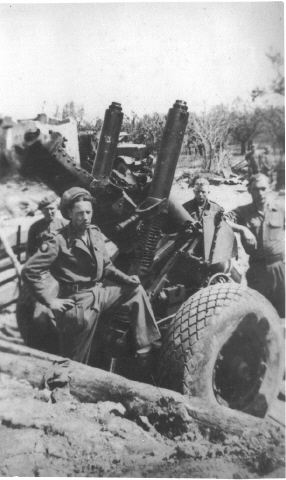Poles of the 2nd Artillery Group, 2nd Polish Corps, man a heavy artillery piece bombarding German positions. No one was keener to liberate their homeland than the Poles. 2nd Artillery Group: 9th,10th,11th,12th and 13th heavy artillery regiments (pulk artylerii ciezkiej)
General Wladislaw Sikorski, the head of the Polish Government in London, entered into negotiations with Soviet Government to free Poles detained in the USSR and to recruit them to form a new army. As a result, agreements were signed in July and August 1941 and two Polish infantry divisions began to be organised int the area of Orenburg. Maj. General Wladislaw Anders, himself a former prisoner, was appointed to command the new army. In December 1941, as a result of new negotiations, it was decided to expand the Polish Army to six divisions and also to transfer a contingent of 25,000 men to the West. The move to Iran started on 23 March 1942. Due to ever-increasing Soviet reluctance to provide supplies to the new army, which was reduced to starvation, and the Soviets’ general lack of co-operation, another Polish contingent left the Soviet Union in August.
Once in the Middle East, the Poles went through a period of reorganisation and training under the designation of Polish Army in the East. The Independent Carpathian Rifle Brigade which had won fame at Tobruk and in the Western Desert, with units from the Soviet Union, became the 3rd Carpathian Rifle Division. The other formations created at that time were the 5th ‘Kresowa’ Infantry Division, the 2nd Armoured Brigade and the 2nd Artillery Group. In June 1943, this force was redesignated 2nd Polish Corps. The 1st Polish Corps was formed in the United Kingdom.
During July and August, the 2nd Polish Corps moved to Palestine where it participated in the autumn manoeuvres were partly held in mountainous areas in order to acquaint the troops with the terrain they would encounter after arriving at their new destination, Italy. Units of the 3rd Carpathian Rifle Division started to disembark at Taranto on 21 December 1943. The transfer of all the Polish forces from Egypt continued until the middle of April 1944, troops landing at Taranto, Bari and Naples.
The Corps was followed by the 2nd Corps Base which comprised the 7th Infantry Division as training reserve, training and servicing centres, hospitals and other supporting units. The first Polish unit to see action in Italy was the Independent Commando Company, which fought on the Garigliano river.
Due to shortage of manpower. The two divisions each comprised only two infantry brigades: the 3rd Division had the 1st and the 2nd Carpathian Rifle Brigade; and the 5th Division contained the 5th ‘Wilenska’ and the 6th ‘Lwowska’ Infantry Brigade. The rest of the divisional order of battle followed the British pattern: three field artillery regiments; one anti-tank and one anti-aircraft artillery regiment; a reconnaissance regiment – the 12th ‘Podolski’ Lancers and the 15th ‘Poznanski’ Lancers in the 3rd and 5th Divisions, respectively; and all the other supporting and servicing units of the average infantry division.
The Corps’ 2nd Armoured Brigade comprised three armoured regiments and support units.
Finding replacements for the severe casualties suffered by the corps posed a constant problem because the Polish Government’s policy was to deploy the corps together. The problem was solved by enlisting Poles from POW camps – men from the Polish territory annexed by Germany in 1939 who had later forcibly been recruited into the Wehrmacht, and subsequently captured by the Allies. Apart from supplementing the losses. This unconventional method constantly reinforced the 2nd Corps. A third brigade was formed within both infantry divisions, the 2nd Armoured Brigade became a division and a new armoured brigade, the 14th ‘Wielkopolska’, was formed as well as new regiments
